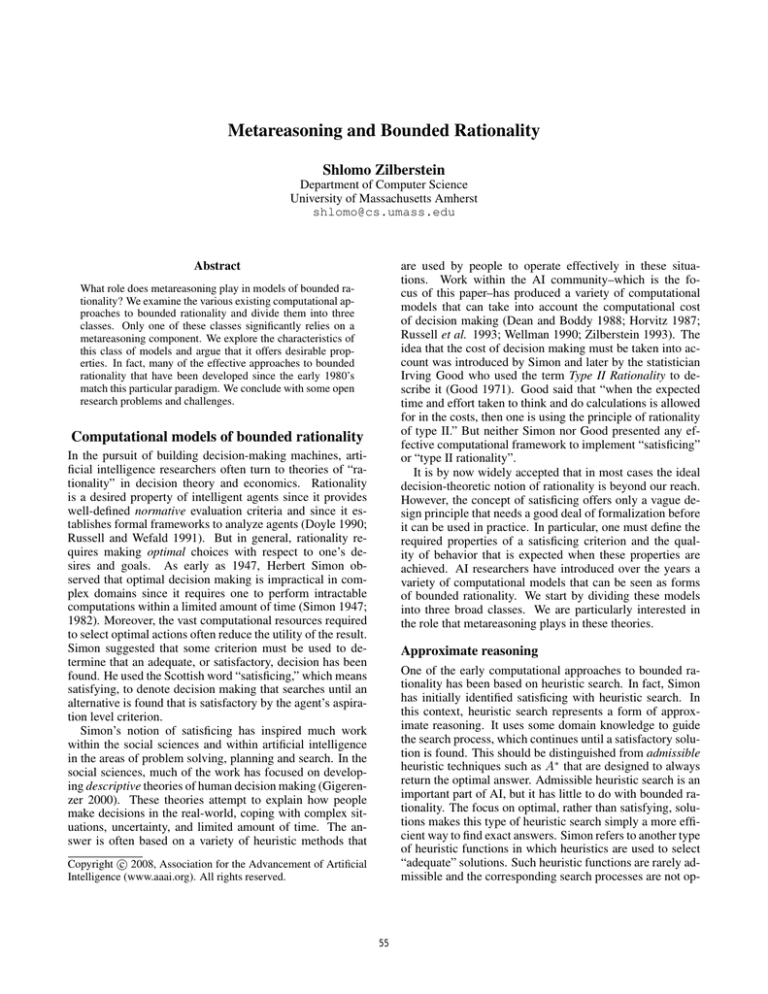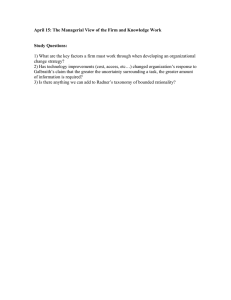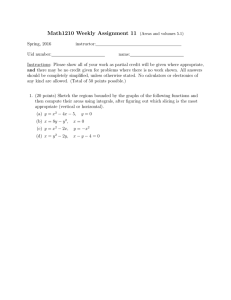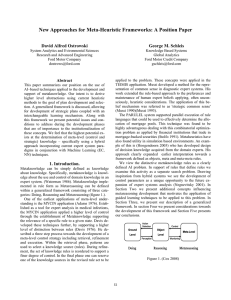
Metareasoning and Bounded Rationality
Shlomo Zilberstein
Department of Computer Science
University of Massachusetts Amherst
shlomo@cs.umass.edu
Abstract
are used by people to operate effectively in these situations. Work within the AI community–which is the focus of this paper–has produced a variety of computational
models that can take into account the computational cost
of decision making (Dean and Boddy 1988; Horvitz 1987;
Russell et al. 1993; Wellman 1990; Zilberstein 1993). The
idea that the cost of decision making must be taken into account was introduced by Simon and later by the statistician
Irving Good who used the term Type II Rationality to describe it (Good 1971). Good said that “when the expected
time and effort taken to think and do calculations is allowed
for in the costs, then one is using the principle of rationality
of type II.” But neither Simon nor Good presented any effective computational framework to implement “satisficing”
or “type II rationality”.
It is by now widely accepted that in most cases the ideal
decision-theoretic notion of rationality is beyond our reach.
However, the concept of satisficing offers only a vague design principle that needs a good deal of formalization before
it can be used in practice. In particular, one must define the
required properties of a satisficing criterion and the quality of behavior that is expected when these properties are
achieved. AI researchers have introduced over the years a
variety of computational models that can be seen as forms
of bounded rationality. We start by dividing these models
into three broad classes. We are particularly interested in
the role that metareasoning plays in these theories.
What role does metareasoning play in models of bounded rationality? We examine the various existing computational approaches to bounded rationality and divide them into three
classes. Only one of these classes significantly relies on a
metareasoning component. We explore the characteristics of
this class of models and argue that it offers desirable properties. In fact, many of the effective approaches to bounded
rationality that have been developed since the early 1980’s
match this particular paradigm. We conclude with some open
research problems and challenges.
Computational models of bounded rationality
In the pursuit of building decision-making machines, artificial intelligence researchers often turn to theories of “rationality” in decision theory and economics. Rationality
is a desired property of intelligent agents since it provides
well-defined normative evaluation criteria and since it establishes formal frameworks to analyze agents (Doyle 1990;
Russell and Wefald 1991). But in general, rationality requires making optimal choices with respect to one’s desires and goals. As early as 1947, Herbert Simon observed that optimal decision making is impractical in complex domains since it requires one to perform intractable
computations within a limited amount of time (Simon 1947;
1982). Moreover, the vast computational resources required
to select optimal actions often reduce the utility of the result.
Simon suggested that some criterion must be used to determine that an adequate, or satisfactory, decision has been
found. He used the Scottish word “satisficing,” which means
satisfying, to denote decision making that searches until an
alternative is found that is satisfactory by the agent’s aspiration level criterion.
Simon’s notion of satisficing has inspired much work
within the social sciences and within artificial intelligence
in the areas of problem solving, planning and search. In the
social sciences, much of the work has focused on developing descriptive theories of human decision making (Gigerenzer 2000). These theories attempt to explain how people
make decisions in the real-world, coping with complex situations, uncertainty, and limited amount of time. The answer is often based on a variety of heuristic methods that
Approximate reasoning
One of the early computational approaches to bounded rationality has been based on heuristic search. In fact, Simon
has initially identified satisficing with heuristic search. In
this context, heuristic search represents a form of approximate reasoning. It uses some domain knowledge to guide
the search process, which continues until a satisfactory solution is found. This should be distinguished from admissible
heuristic techniques such as A∗ that are designed to always
return the optimal answer. Admissible heuristic search is an
important part of AI, but it has little to do with bounded rationality. The focus on optimal, rather than satisfying, solutions makes this type of heuristic search simply a more efficient way to find exact answers. Simon refers to another type
of heuristic functions in which heuristics are used to select
“adequate” solutions. Such heuristic functions are rarely admissible and the corresponding search processes are not op-
c 2008, Association for the Advancement of Artificial
Copyright Intelligence (www.aaai.org). All rights reserved.
55
has been also referred to as rational metareasoning (Horvitz
1989) and metalevel rationality (Russell 1995) to distinguish
it from perfect rationality. This offers one precise form of
bounded rationality that we will examine in further details
in the next section.
It should be noted that optimal metareasoning can result in
arbitrary poor agent performance. This is true because we do
not impose upfront any constraints on the object-level deliberation process, in terms of either efficiency or correctness.
Nevertheless, we will see later that this presents an attractive framework for bounded rationality and that performance
guarantees can be established once additional constraints are
imposed on the overall architecture.
timal in any formal sense. Systems based on non-admissible
heuristic functions are often harder to evaluate, especially
when optimal decisions are not available.
Although it is often assumed that approximate reasoning
is aimed at finding approximate answers to a given problem,
it can take different forms. For example, the initial problem
can be reformulated in such a way that reduces its complexity. The reformulation process could be approximate, yielding a new problem that is easier to solve because it does not
retain all the details of the original problem. The resulting
problem could then be solved efficiently and perhaps optimally and the obtained solution can then be used as an approximate solution for the original problem. One example of
such a process–also referred to as approximate modeling–is
when deterministic action models are used in planning, ignoring the uncertainty about action failures. Combined with
suitable runtime execution monitoring, such an approach
could be beneficial. In fact, the winner of a recent probabilistic planning competition was a planner based on these
principles. Regardless of the form of approximation, approximate reasoning techniques can be complemented by
some form of explicit or implicit metareasoning. Metareasoning in this context is a mechanism to make certain runtime decisions by reasoning about the problem solving–or
object-level–reasoning process. This can be done either explicitly, by introducing another level of reasoning as shown
in Figure 1, or implicitly, by pre-compiling metareasoning
decisions into the object-level reasoning process at design
time. For example, metareasoning has been used to develop
search control strategies–both explicitly and implicitly. In
some cases, the goal is specifically to optimize the tradeoff between search effort and quality of results (Russell and
Wefald 1991). Thus, metareasoning could play a useful role
in certain forms of approximate reasoning, but it is not–by
definition–a required component.
While it is clear that any form of bounded rationality essentially implies that the agent performs approximate reasoning, the opposite is not necessarily true. Generally,
frameworks for approximate reasoning do not provide any
formal guarantees about the overall performance of the
agent. Such guarantees are necessary to offer a satisfactory definition of bounded rationality and thus restore some
sort of qualified optimality. So, we do not view a heuristic
rule that proves useful in practice to be in itself a framework
for bounded rationality if it does not have additional formal
properties. The rest of this section describes two additional
approaches that offer such precise properties.
Bounded optimality
Bounded optimality techniques seek to restore a stonger notion of optimality in decision making in the face of computational complexity and limited resources. That is, instead of
building systems that can find “sufficiently good” answers,
the goal is to find a maximally successful program that can
compute these answers. Optimality is defined with respect
to a particular space of possible implementations (Russell
and Wefald 1991; Russell 1995).
Russell and Wefald (1991) say that an agent exhibits
bounded optimality “if its program is a solution to the constraint optimization problem presented by its architecture.”
This approach marks a shift from optimization over actions
to optimization over programs. The program is bounded optimal for a given computational device for a given environment, if the expected utility of the program running on the
device in the environment is at least as high as that of all
other programs for the device. When the space of programs
is finite, one can certainly argue that a bounded optimal solution exists. Finding it, however, could be very hard.
Russell, Subramanian, and Parr (Russell et al. 1993) give
an efficient construction algorithm that generates a bounded
optimal program for a particular restricted class of agent architectures, in which a program consists of a sequence of
decision procedures. The decision procedures are represented using condition-action rules. The authors admit that
bounded optimality as defined above may be hard to achieve
for most problems. They propose a weaker notion of asymptotic bounded optimality as a more practical alternative. The
latter case requires that the program performs as well as the
best possible program on any problem instance, provided
that its computational device is faster by a constant factor.
To establish bounded optimality, the designer of the
system–not the agent itself, is responsible to identify the
agent reasoning architecture and to prove that the program
satisfies the optimality conditions. In that sense, metareasoning does not play any significant role is this framework.
Certainly there is no requirement that the agent itself be engaged in any form of metareasoning. As long as the agent
program is shown to satisfy the optimality conditions, we
have a bounded optimal agent.
One criticism of bounded optimality is that while the
bounded rationality criterion is very well defined, it is very
hard to achieve in practice as evidenced by the limited number of examples produced following the introduction of the
Optimal metaraesoning
Since metareasoning is a component that monitors and controls object-level deliberation, one could pose the question
of whether the metareasoning process itself is optimal. Optimality here is with respect to the overall agent performance,
given its fixed object-level deliberation capabilities. This is
a well-defined question that sometimes has a simple answer.
For example, metareasoning may focus on the single question of when to stop deliberation and take action. Depending
on how the base-level component is structured, the answer
may or may not be straightforward. Optimal metareasoning
56
5. When and how does execution switches between the
object-level and the meta-level?
6. How much time is consumed by the meta-level reasoning
process? How much of the metareasoning strategy is precomputed offline? What is the online overhead?
7. Is metareasoning optimal? What assumptions are needed
to establish optimality?
8. What can be said about the overall performance of the
agent? Can a bound be established on how close it is to
an ideal perfectly rational agent?
Figure 1: The view of metareasoning as monitoring and controlling object-level reasoning.
Over the 1980’s, a number of decision making frameworks have been developed that match this form of bounded
rationality. In the next section, we describe one such framework in detail and examine the answers to the above questions in that particular case. We then survey briefly a number
of additional frameworks.
concept 15 years ago. Bounded optimality may well be the
most precise formal approach to bounded rationality, but
without further refinement it has little use in practice.
Bounded rationality as optimal metareasoning
We considered three basic approaches to achieve bounded
rationality: approximate reasoning, optimal metareasoning,
and bounded optimality. The latter two approaches represent
very specific, well-defined solutions; everything else falls
under the broad category of approximate reasoning. We argued that the first approach is under-constrained, essentially
allowing any form of approximate reasoning to be a solution, and the third approach is over-constrained, being hard
to implement in practice. This leaves us with optimal metareasoning as the most promising approach for further examination.
We adapt the view of metareasoning as a process that
monitors and controls the object-level reasoning process as
shown in Figure 1. This can take many different forms and
can present metareasoning decisions of various complexities. We will consider an agent to be bounded rational when
its metareasoning component is optimal. That is, given a
particular object-level deliberation model, we look for the
best possible way to control it so as to optimize the actual
ground-level performance of the agent.
There are a number of key questions to answer with respect to any implementation of this framework. The answers
to these questions can help establish additional desired properties of the overall system that are not directly implied by
optimal metareasoning.
Optimal metareasoning with anytime
algorithms
One general approach to bounded rationality is based
on composition and monitoring of anytime algorithms.
Methodologically, problem solving with anytime algorithms
is based on dividing the overall problem into four key subproblems: elementary algorithm construction, performance
measurement and prediction, composability, and meta-level
control of computation.
Elementary algorithm construction covers the problem
of introducing useful tradeoffs between computational resources and output quality in decision making. This fundamental problem has been studied by the AI community
resulting in a variety of “anytime algorithms” (Dean and
Boddy 1988) or “flexible computation” methods (Horvitz
1987) whose quality of results improves gradually as computation time increases. The same problem has been studied within the systems community in the area of “imprecise computation” (Liu et al. 1991). While iterative refinement techniques have been widely used in computer
science, the construction of “well-behaved” anytime algorithms is not obvious. To serve as useful components of a
resource bounded reasoning system, such algorithms should
have certain properties: measurable objective output quality,
monotonicity and consistency of quality improvement, and
marginal decrease in the rate of quality improvement over
time. Constructing good, reusable anytime algorithms is an
important active research area. There are now many existing
anytime algorithms for standard heuristic search, planning
and reasoning tasks.
Performance measurement and prediction covers the
problem of capturing the tradeoff offered by each system
component using a “performance profile”. A good performance profile is a compact probabilistic description of the
behavior of the component. A typical representation is a
mapping from run-time to expected output quality. Recent
results show that conditioning performance profiles on input
quality and other observable features of the algorithm can
improve the precision of run-time quality prediction.
1. What object-level decision making architecture is employed? Is it complete? Is it sound? What tradeoffs it
offers between computational resources and quality of results?
2. How does the metareasoning component model the
object-level reasoning process? What kind of prior
knowledge is available about the efficiency and correctness of the object-level component?
3. What run time information about the state of the objectlevel reasoning process is being monitored? What is
known about the external environment?
4. What control decisions are being made by the meta-level
reasoning process? How do these decisions affect the
object-level component?
57
Composability covers the problem of building modular
resource bounded reasoning system with anytime algorithms
as their components. The fundamental issue is that composition destroys interruptibility–the basic property that defines
anytime algorithms. A two step solution has been developed
to this problem that makes a distinction between “interruptible” and “contract” algorithms (Zilberstein 1993). Contract
algorithms offer a tradeoff between output quality and computation time, provided that the amount of computation time
is determined prior to their activation. The idea is to first
compose the best possible contract algorithm and then make
it interruptible with only a small, constant penalty (Zilberstein and Russell 1996).
Finally, meta-level control covers the problem of runtime allocation of computational resources (or “deliberation
scheduling” (Dean and Boddy 1988)) so as to maximize the
overall performance of the system. In general, meta-level
control involves modeling both the internal problem solving
process and the external environment and manage computational resources accordingly. In domains characterized by
high predictability of utility change over time, the monitoring problem can be solved efficiently using contract algorithms and a variety of strategies for contract adjustment.
In domain characterized by rapid change and a high level
of uncertainty, monitoring must be based on the use of interruptible algorithms and the marginal “value of computation” (Russell and Wefald 1991). An approach to monitoring have been developed that is sensitive to both the cost
of monitoring and to how well the quality of the currently
available solution can be estimated by the run-time monitor. The technique is based on modeling anytime algorithms
as Markov processes and constructing an off-line monitoring policy based on a stochastic model of quality improvement (Hansen and Zilberstein 1996).
Work on anytime algorithms has produced all the key ingredients for building bounded rational agents. In order to
relate this work to the model of bounded rationality we discussed in the previous section, we answer the eight key questions that are associated with that model. We use the work
on anytime algorithms to illustrate the framework and refer to the simple case involving an object-level component
composed of a single anytime algorithm.
4.
5.
6.
7.
1. What object-level decision making architecture is employed?
The basic assumption about the object-level is that it is an
anytime algorithm, normally an interruptible one. Some
anytime algorithms, such as anytime A* (Hansen et al.
1997), guarantee convergence on the optimal solution, but
this is not generally required.
8.
2. How does the metareasoning component model of the
object-level reasoning process? What kind of prior
knowledge is available about the efficiency and correctness of the object-level component?
Some form of a performance profile is normally used as
prior knowledge. It characterize the tradeoff between runtime and quality of results. Both deterministic and probabilistic models have been developed.
level reasoning process is being monitored? What is
known about the external environment?
Typically the two key parameters are total runtime and the
quality of the current solution. In some cases, the quality
of the current solution can only be estimated using certain
features of the solution. In that case, the metareasoning
component need to estimate the quality of the solution using the available features (Hansen and Zilberstein 2001)
What control decisions are being made by the meta-level
reasoning process? How do these decisions affect the
object-level component?
The most simple example is when the metareasoning
component only decides when to stop the anytime algorithm and return the current solution. When each activation of the metareasoning component takes non-negligible
amount of time, the decision could also include the frequency of monitoring (Hansen and Zilberstein 2001).
When and how does execution switches between the
object-level and the meta-level?
In most cases, monitoring of anytime algorithm is done
periodically at some fixed intervals, although the techniques mentioned above can also optimize the frequency
of monitoring and vary it at runtime.
How much time is consumed by the meta-level reasoning
process? How much of the metareasoning strategy is precomputed offline? What is the online overhead?
Work on anytime algorithms often relies on pre-computed
control strategies that are generated offline using the performance profile of the algorithm. Simple control strategies, such as a myopic approaches that stops the computation when the marginal value of computation becomes
negative–can be computed online with little overhead.
When solution quality must be estimated at runtime, this
needs to be done online and could introduce a significant
overhead.
Is metareasoning optimal? What assumptions are needed
to establish optimality?
Optimal metareasoning has been introduced for a wide
range of scenarios involving anytime algorithms using
certain assumptions about the performance profile. Typical assumptions are that the performance profile satisfies the diminishing returns property. A range of situations in which optimal metareasoning can be established
is described in (Zilberstein 1996; Hansen and Zilberstein
2001).
What can be said about the overall performance of the
agent? Can a bound be established on how close it is to
an ideal perfectly rational agent?
It depends on how the quality of results produced by the
anytime algorithm is measured. Generally, no performance bound exist because the anytime algorithm being
monitored is not subject to any constraints in terms of its
efficiency or correctness. But when the quality measure
provides an error bound on how close the results is to the
optimal answer, we can establish a worst-case bound.
To summarize, there are many instances of optimal metareasoning involving anytime algorithms as object-level delib-
3. What run time information about the state of the object-
58
tistical Inference, pp. 108–141. Toronto: Holt, Rinehart,
Winston, 1971.
E. A. Hansen and S. Zilberstein. Monitoring the progress
of anytime problem solving. Proceedings of the Thirteenth
National Conference on Artificial Intelligence, pp. 1229–
1234, Portland, Oregon, 1996.
E. A. Hansen and S. Zilberstein. Monitoring and control of
anytime algorithms: A dynamic programming approach.
Artificial Intelligence, 126(1-2):139–157, 2001.
E. A. Hansen, S. Zilberstein, and V. A. Danilchenko. Anytime heuristic search: First results. Technical Report 9750, Computer Science Department, University of Massachusetts, 1997.
E. J. Horvitz. Reasoning about Beliefs and Actions under
Computational Resource Constraints. Proceedings of the
1987 Workshop on Uncertainty in Artificial Intelligence,
Seattle, Washington, 1987.
E. J. Horvitz. Rational metareasoning and compilation for
optimizing decisions under bounded resources Proceedings of Computational Intelligence, Milan, Italy, 1989.
J. W. S. Liu, K. J. Lin, W. K. Shih, A. C. Yu, J. Y. Chung
and W. Zhao. Algorithms for scheduling imprecise computations. em IEEE Computer, 24:58-68, 1991.
M. Petrik and S. Zilberstein. Learning parallel portfolios
of algorithms. Annals of Mathematics and Artificial Intelligence, 48(1-2):85-106, 2006.
S. J. Russell, D. Subramanian and R. Parr. Provably
bounded optimal agents. Proceedings of the Thirteenth
International Joint Conference on Artificial Intelligence,
pp. 338–344, Chambery, France, 1993.
S. J. Russell and E. H. Wefald. Do the Right Thing: Studies in limited rationality. Cambridge, Massachusetts: MIT
Press, 1991.
S. J. Russell. Rationality and intelligence Proceedings of
the Fourteenth International Joint Conference on Artificial
Intelligence, pp. 950–957, 1995.
H. A. Simon. Administrative Behavior. New York:
Macmillan, 1947.
H. A. Simon. Models of bounded rationality, Volume 2.
Cambridge, Massachusetts: MIT Press, 1982.
M. P. Wellman. Formulation of Tradeoffs in Planning Under Uncertainty. London: Pitman, 1990.
S. Zilberstein. Operational Rationality through Compilation of Anytime Algorithms. Ph.D. dissertation, Computer Science Division, University of California at Berkeley, 1993.
S. Zilberstein. The use of anytime algorithms in intelligent
systems. AI Magazine, 17(3):73–83, 1996.
S. Zilberstein and S. J. Russell. Optimal composition
of real-time systems. Artificial Intelligence, 82:181–213,
1996.
S. Zilberstein, F. Charpillet, and P. Chassaing. Optimal
sequencing of contract algorithms. Annals of Mathematics
and Artificial Intelligence, 39(1-2):1–18, 2003.
eration method. There are also examples of optimal metareasoning with respect to other object-level components such
as algorithm portfolios (Petrik and Zilberstein 2006), and
contract algorithms (Zilberstein et al. 2003). These examples illustrate that this well-defined model of bounded rationality can be implemented in practice in many domains.
Conclusion
We examined three different formal approaches to bounded
rationality. One approach–based on optimal metareasoning–
seems particularly attractive because it is both relatively
easy to implement and it provides some formal guarantees
about the behavior of the agent. We examined several instantiations of this approach using anytime algorithms and
provided a characterization of the relationship between the
object-level and metareasoning components. These examples show that metareasoning plays an important role in one
of the key approaches to bounded rationality.
One interesting challenge is to try to establish mechanisms to bound the performance different between the more
practical approach based on optimal metareasoning with a
given object-level component and a bounded optimal agent,
using the same architecture. Creating a bounded optimal
agent is hard, but bounding the performance gap might be
possible.
Another challenge is to develop models of bounded rationality suitable for multiple decision makers in either cooperative or competitive settings. When agents operate independently and cannot be controlled in a centralized manner, their metareasoning components need to coordinate. A
simple example is when one agent decides to stop thinking
and take action, but the other may see a need to continue
deliberation. There has been little work so far on coordination between the metareasoning components of collaborative agents. The situation is even more complicated in competitive settings when agents need to monitor the deliberation processes of other agents, on which they have very little
knowledge.
Acknowledgments
This work was supported in part by the National Science Foundation under Grant No. IIS-0535061 and by
the Air Force Office of Scientific Research under Grant
No. FA9550-08-1-0181.
References
T. Dean and M. Boddy. An analysis of time-dependent
planning. Proceedings of the Seventh National Conference
on Artificial Intelligence, pp. 49–54, Minneapolis, Minnesota, 1988.
J. Doyle. Rationality and its roles in reasoning. Proceedings of the Eighth National Conference on Artificial Intelligence, pp. 1093–1100, Boston, Massachusetts, 1990.
G. Gigerenzer. Adaptive Thinking: Rationality in the Real
World. Oxford University Press, 2000.
I. J. Good. Twenty-seven principles of rationality. In Godambe, V. P. & Sprott, D. A. (Eds.), Foundations of Sta-
59








